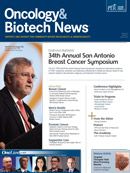Publication
Article
Oncology & Biotech News
Navigation Program Shows Limited Benefit in Underserved, Urban Women With Breast Cancer
Author(s):
The use of a navigation program for an urban safety net breast cancer population has only a moderate effect on the time from symptom presentation to treatment.
Nisreen A. Haideri, MD
Researchers have reported that the use of a navigation program for an urban safety net breast cancer population has only a moderate effect on the time from symptom presentation to treatment.
Nisreen A. Haideri, MD, with the University of Kansas Cancer Center in Westwood, and a colleague reviewed multiple outcomes in women who were diagnosed with adenocarcinoma of the breast at a safety net hospital before and after the implementation of a patient navigation program. A so-called safety net hospital provides a significant level of care to low-income, uninsured, and vulnerable populations.
The most important role of patient navigation is to assist an individual with a suspicious cancer-related finding in order to receive a timely diagnosis and treatment, which is best achieved through one-on-one contact with the patient from the time of initial suspicion of a cancer diagnosis. Patient navigation programs aim to cut socioeconomic and racial disparities between US population groups in cancer incidence, treatment, and outcome.
While patient navigation programs have become increasingly popular nationwide, there is little research about their impact on cancer outcomes, they noted.
The cohort included 103 women who were diagnosed between January 1, 1997, and December 31, 1999, before a navigation program was introduced and had standard breast cancer management. The cohort also included 219 women diagnosed between January 1, 2000, and December 31, 2003, post-navigation. Overall, 157 women (72%) received navigation services.
Implementation of the navigation program had a “very modest” effect on the median time from initial presentation, which is defined as either the date of an abnormal screening test or the date of initial evaluation of a breast mass to the date of definitive treatment. The time from symptom presentation to first treatment was 42 days before the program was introduced and 33 days afterwards.
The study also showed that the navigation program did not influence the stage of presentation or overall survival.
The authors acknowledged that their findings are “open to differential outside influences” given the study’s nonrandomized, historical control design. On the other hand, the study design allowed the investigators to determine the impact of the navigator program on all women with breast cancer at their institution instead of only those women who consented to participate in the program who can be expected to have better outcomes as a result of their active involvement in seeking medical care, they said.
Finally, Haideri and her colleague maintain that it is not likely that a single approach can decrease the disparities in cancer outcomes in all settings. “Programs that focus on easing access to cancer diagnostic and treatment services may be quite useful and effective in some settings, whereas other communities may benefit far more from community outreach programs that emphasize primary care and cancer screening services,” they wrote.
Haideri NA, Moormeier JA. Impact of patient navigation from diagnosis to treatment in an urban safety net breast cancer population [published online ahead of print September 8, 2011]. J Cancer. 2011;2:467-473.

Latest Conference Coverage

Zongertinib Elicits Durable Responses in Pretreated Advanced HER2-Mutant NSCLC

Lenvatinib Shows Efficacy in Advanced HCC Post-Progression on Atezolizumab/Bevacizumab

Sacituzumab Govitecan Does Not Significantly Improve OS in Pretreated Urothelial Carcinoma

Active Monitoring Is Noninferior to Guideline Concordant Care in Low-Risk DCIS
2 Commerce Drive
Cranbury, NJ 08512





